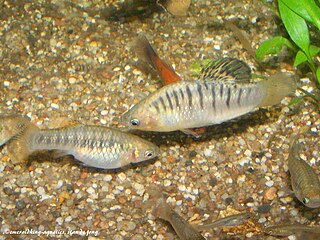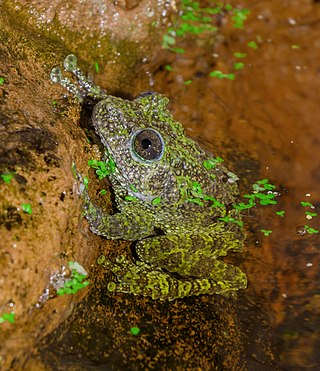
The Pedder galaxias is an Australian freshwater fish. It is considered to be extinct in the wild since 2005 by the EPBC Act, and was originally found only in Lake Pedder in Tasmania.

The longnose sucker is a species of cypriniform freshwater fish in the family Catostomidae. It is native to North America from the northern United States to the top of the continent. It is also found in Russia in rivers of eastern Siberia, and thus one of only two species of sucker native to Asia.

Anomalochromis is a genus of fish in the family Cichlidae, containing the single species Anomalochromis thomasi, the African butterfly cichlid. It is a small cichlid growing to a length of 6–8 centimetres (2.4–3.1 in). The natural habitat of A. thomasi is Sierra Leone, Liberia and Guinea, mainly in smaller streams. The fish are typically found in slightly acidic, oxygen rich water with other west African cichlid genera such as Hemichromis and Pelvicachromis.

The humpbacked limia or black-barred limia is a species of poeciliid endemic indigenous to Haiti. This species grows to a length of 5.2 centimetres (2.0 in) SL. Its natural habitat is in streams and lagoons, where it is associated with the cover of aquatic plants. It is also found in the aquarium trade.
Amolops monticola is a species of frog in the family Ranidae, the "true frogs". It is found in the Northeast India, eastern Nepal, and western China, although there is some uncertainty regarding the Chinese records. It probably also occurs in the intervening Bhutan. Common names mountain sucker frog, mountain stream frog, mountain torrent frog, and mountain cascade frog have been coined for it.
The aquatic rat, Ecuador fish-eating rat, fish-eating rat or Ecuadoran ichthyomyine is a South American species of semiaquatic rodent in the family Cricetidae. It is the only species in the genus Anotomys. This species is currently considered endangered. It is thought to be nocturnal and feeds on aquatic arthropods and insects. It is found in small ranges along the Andes.

Desmognathus fuscus is a species of amphibian in the family Plethodontidae. The species is commonly called the dusky salamander or northern dusky salamander to distinguish it from populations in the southern United States which form several distinct species, the southern dusky salamanders. The northern dusky salamander is the most widespread representative of its genus in Canada. It can be found in eastern North America from extreme eastern Canada in New Brunswick south to South Carolina. The size of the species' total population is unknown, but is assumed to easily exceed 100,000. The species' habitat differs somewhat geographically; dusky salamanders in the northern part of the range prefer rocky woodland streams, seepages, and springs, while those in the south favor floodplains, sloughs, and muddy places along upland streams. They are most common where water is running or trickling. They hide under various objects, such as leaves or rocks, either in or near water. Alternatively, they may enter burrows for protection. The dusky salamander lays its eggs close to water under moss or rocks, in logs, or in stream-bank cavities. The larval stage which follows is normally aquatic.

Nannophrys ceylonensis, commonly known as the Sri Lanka rock frog or the Ceylon streamlined frog, is a species of frog. It used to be placed in the large frog family Ranidae but a phylogenetic study was undertaken using DNA sequences and it is now included in the family Dicroglossidae. It is endemic to Sri Lanka where its natural habitats are subtropical or tropical moist lowland forests, subtropical or tropical moist montane forests, rivers and streams.

Nannophrys marmorata, commonly known as Kirtisinghe's rock frog or marbled streamlined frog, is a species of frog endemic to Sri Lanka. It used to be placed in the large frog family Ranidae but a phylogenetic study was undertaken using DNA sequences and it is now included in the family Dicroglossidae. Its natural habitats are tropical moist lowland forests, moist montane forests, rivers and streams. It is threatened by habitat loss.

Theloderma corticale is a species of frog in the family Rhacophoridae. It is found in northern Vietnam, south–central Laos, and southern China.

The California giant salamander is a species of salamander in the family Ambystomatidae. Dicamptodon ensatus is endemic to California, in the western United States. The species once additionally included individuals now belonging to the species D. aterrimus and D. tenebrosus, under the common name Pacific giant salamander, which now refers to the genus and family.

The Japanese water shrew, also called the flat-headed water shrew, is a species of mammal in the family Soricidae. It is endemic to Japanese Islands, Honshu and Kyushu. They are considered extinct in Shikoku.
Axelrod's rainbowfish is a species of rainbowfish in the subfamily Melanotaeniinae. It is found in Papua New Guinea in the Yungkiri stream in the north western part of that nation. Typically its preferred habitat is a narrow stream with gentle moving, cloudy water surrounded by lush rainforest.
The redband darter is a species of freshwater ray-finned fish, a darter from the subfamily Etheostomatinae, part of the family Percidae, which also contains the perches, ruffes and pikeperches. It is endemic to the state of Tennessee in the eastern United States.

Platyhypnidium riparioides, the long-beaked water feathermoss, is a species of aquatic moss commonly found in many regions. This species is among the largest aquatic mosses growing up to 15 cm long. P. riparioides grows in a procumbent or pendulous fashion along rocks and tree roots and may form extensive lax mats of many intermingled plants. It is widely distributed South of the Arctic and can grow abundantly in suitable areas.

Betta enisae is a species of gourami endemic to the Kapuas River basin of Indonesia. It is an inhabitant of forest streams with slightly acidic waters, and can mostly be found in the shallows amongst the leaf litter. This species grows to a length of 5.9 cm (2.3 in). It is commonly used as bait by local fishermen and has been found in the aquarium trade. The specific name of this fish honours Enis Widjanarti who assisted Kottelat in his expedition to the Kapuas Lakes.

Zingel zingel, the zingel, is a species of freshwater ray-finned fish in the family Percidae. It is found in fast-flowing streams in southeastern Europe. It is the type species of the genus Zingel.
Cyperus alopecuroides, commonly known as the foxtail flatsedge, is a sedge of the family Cyperaceae that is native to parts of Africa, Asia and Australia.

Lycopodiella alopecuroides, the foxtail clubmoss, is a species of perennial vascular plant in the club-moss family, Lycopodiaceae. It is commonly found along the Atlantic seaboard and has been recently been discovered in the state of Maine. The family, Lycopodiaceae contains nearly 15 genera and about 375 species

Mitchell's Grove Nature Preserve is a 184 acres (74 ha) nature Preserve located in LaSalle County, Illinois, situated between Tomahawk Creek and the Little Vermillion River north of their confluence. It is composed of diverse terrain with over 300 plant species present. While much of the upland area is oak savanna and prairie, the bottomlands consist of several different types of mesic forest with diverse plant communities. The site was given to the state of Illinois by William and Irene Mitchell in 1997.















